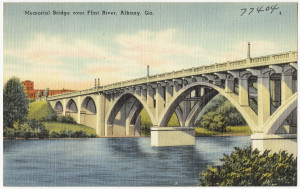In late April, U.S. District Court Judge Mark A. Goldsmith, in Concerned Pastors for Social Action, et al. v. Nick A. Kouri, et al.,  issued an interesting Order Regarding Disqualification. During an April 6, 2016 status conference in this matter, the Court to the parties “information regarding its consumption of water whose source was the Flint River, during the period of April 2014 to August 2014, a time period when its duty station was at the Flint Divisional courthouse.” On the same day, the Court issued an order instructing “the parties to file any objections pertaining to the Court’s continued participation in the matter.” At issue was Title 28 U.S.C. § 455(a), which provides that any judge “of the United States shall disqualify himself in any proceeding in which his impartiality might reasonably be questioned.”
issued an interesting Order Regarding Disqualification. During an April 6, 2016 status conference in this matter, the Court to the parties “information regarding its consumption of water whose source was the Flint River, during the period of April 2014 to August 2014, a time period when its duty station was at the Flint Divisional courthouse.” On the same day, the Court issued an order instructing “the parties to file any objections pertaining to the Court’s continued participation in the matter.” At issue was Title 28 U.S.C. § 455(a), which provides that any judge “of the United States shall disqualify himself in any proceeding in which his impartiality might reasonably be questioned.”
Obtaining Insurance Coverage for Climate Change Investigations
UPDATE: When Attorneys General Attack II
In When Attorneys General Attack, Pillsbury attorneys Sheila McCafferty Harvey, Joseph Jean, Carolina Fornos and Benjamin Tievsky discuss the New York State Office of the Attorney General’s and other jurisdictions’ power to aggressively scrutinize energy companies’ public statements on the subject of climate change. In the alert, they provide strategies for managing and obtaining insurance coverage for these investigations.
CGL Policy Double Standard for Construction Defects
In A Double Standard in Construction Defect Coverage Cases?, I discuss the recent decision of Allied Property & Casualty Insurance Co. v. Metro North Condominium Associates. This decision highlights why only a minority of courts still hold to the fiction that construction defects cannot give rise to an “occurrence” covered under a commercial general liability (CGL) policy, why construction companies and others need to understand how this rule is applied, and why contractors may want to avoid choosing Illinois law to control their CGL policy.
10th Circ.: Permit Issuance Is Not State Action for Purposes of 14th Amendment
 On April 19, 2016, the U.S. Court of Appeals for the Tenth Circuit, in Wasatch Equality, et al., v. Alta Ski Lifts Company, et al., affirmed the lower court’s dismissal of a lawsuit claiming that the U.S. Forest Service, in routinely approving a permit to operate the Alta Ski area in Utah, unconstitutionally discriminated against a group of snowboarders who were banned from using these ski lift facilities by an edict of the ski resort’s operators. Ultimately, the Court of Appeals concluded that “[e]ven if we grant all reasonable inferences in Wasatch’s favor, the pleaded facts at best establish that each year the Forest Service—with knowledge of the snowboard ban—reviews and approves Alta’s site plan and receives from Alta a usage fee. This isn’t enough to establish state action for purposes of the Fourteenth Amendment.”
On April 19, 2016, the U.S. Court of Appeals for the Tenth Circuit, in Wasatch Equality, et al., v. Alta Ski Lifts Company, et al., affirmed the lower court’s dismissal of a lawsuit claiming that the U.S. Forest Service, in routinely approving a permit to operate the Alta Ski area in Utah, unconstitutionally discriminated against a group of snowboarders who were banned from using these ski lift facilities by an edict of the ski resort’s operators. Ultimately, the Court of Appeals concluded that “[e]ven if we grant all reasonable inferences in Wasatch’s favor, the pleaded facts at best establish that each year the Forest Service—with knowledge of the snowboard ban—reviews and approves Alta’s site plan and receives from Alta a usage fee. This isn’t enough to establish state action for purposes of the Fourteenth Amendment.”
San Francisco: First City to Require Fully Paid Parental Leave
In New Legislation Makes San Francisco the First City to Mandate Fully Paid Parental Leave for Employees, Pillsbury attorneys Paula Weber and Erica Turcios discuss the San Francisco Board of Supervisors’ unanimous approval of legislation that requires most San Francisco employees to receive six weeks of fully paid parental leave. Enforcement is set to begin on January 1, 2017.
Texas Court of Appeals Issues Important State Superfund Order
In a “case of first impression,” U.S. Court of Appeals for the Third Circuit, sitting in Austin, in TCEQ v. Exxon Mobil Corporation, et al., issued an important decision interpreting the scope of the Texas Solid Waste Disposal Act (TSWDA) as it pertains to judicial review of and the burden of proof for certain administrative cleanup orders issued by the Texas Commission on Environmental Quality (TCEQ). In general, relatively few opinions have been issued interpreting the TSWDA, and in particular, Subpart F, which is the Texas counterpart to CERCLA (or Superfund) entitled “Registry and Cleanup of Certain Hazardous Waste Facilities.” Given the significance of this decision, an appeal to the Texas Supreme Court seems likely.
sitting in Austin, in TCEQ v. Exxon Mobil Corporation, et al., issued an important decision interpreting the scope of the Texas Solid Waste Disposal Act (TSWDA) as it pertains to judicial review of and the burden of proof for certain administrative cleanup orders issued by the Texas Commission on Environmental Quality (TCEQ). In general, relatively few opinions have been issued interpreting the TSWDA, and in particular, Subpart F, which is the Texas counterpart to CERCLA (or Superfund) entitled “Registry and Cleanup of Certain Hazardous Waste Facilities.” Given the significance of this decision, an appeal to the Texas Supreme Court seems likely.
U.S. Fish and Wildlife Ordered to Reconsider Delisting of N. American Wolverine
The courts continue to be busy issuing significant Endangered Species Act (ESA) rulings. In the latest one, issued in early  April, the U.S. District Court for Montana, Missoula Division, in Defenders of Wildlife v. Jewell, et al., vacated the U.S. Fish and Wildlife Service’s withdrawal of its proposed listing of the North American Wolverine as an endangered species in its 85-page opinion. The opinion includes a very interesting account of the Service’s internal struggles to grapple with the import of this listing, and the reliance it placed on climate change modeling, which generated considerable criticism.These decisions are always noteworthy because of the implications on development projects. One such implication is a listed species must be considered in federal permitting matters.
April, the U.S. District Court for Montana, Missoula Division, in Defenders of Wildlife v. Jewell, et al., vacated the U.S. Fish and Wildlife Service’s withdrawal of its proposed listing of the North American Wolverine as an endangered species in its 85-page opinion. The opinion includes a very interesting account of the Service’s internal struggles to grapple with the import of this listing, and the reliance it placed on climate change modeling, which generated considerable criticism.These decisions are always noteworthy because of the implications on development projects. One such implication is a listed species must be considered in federal permitting matters.
The “Panama Papers” – What Next?
In The “Panama Papers” and the Secret World of Shell Corporations, my colleagues Carolina Fornos, Mark Hellerer,  Maria Galeno, Joseph Jean, Alexander Hardiman, William Sullivan, Nancy Fischer, Nora Burke and Danielle Vrabie, discuss a leak of 11.5 million documents from a law firm in Panama that may implicate politicians, criminals, and celebrities in sheltering of fortunes in offshore tax havens through the use of shell companies. Financial institutions and others may need to consider whether they are implicated by these events, assess the risks and how to minimize exposure, if any, and whether insurance coverage is available.
Maria Galeno, Joseph Jean, Alexander Hardiman, William Sullivan, Nancy Fischer, Nora Burke and Danielle Vrabie, discuss a leak of 11.5 million documents from a law firm in Panama that may implicate politicians, criminals, and celebrities in sheltering of fortunes in offshore tax havens through the use of shell companies. Financial institutions and others may need to consider whether they are implicated by these events, assess the risks and how to minimize exposure, if any, and whether insurance coverage is available.
Additional Source: FinCEN’s First GTOs of 2016 Directed at U.S. Title Insurance Companies and “All Cash” Purchases
Photo: Sellchi Kusunoki, Bunch of Papers, Taken Oct. 16, 2011 – Creative Commons
Texas Supreme Court: Protections of Governmental Immunity Remain Robust But Are Not Absolute
On April 1, 2016, the Texas Supreme Court, in Houston Belt & Terminal Railroad Co., et al.. v. City of Houston, et al., reviewed the implementation of the City of Houston’s 2011 drainage fee ordinance. The petitioner railroad companies were assessed substantial new annual city drainage fees of $3 million by the City’s Director of Public Works. The Director determined that all of the railroads’ properties within the City of Houston “benefitted” – a term in the city ordinance—from the City’s drainage system, and that 93 million square feet of railroad property was “impervious,” allowing storm water to runoff into the drainage system which collected and otherwise managed this runoff. The Director made his determination of assessable property on the basis of aerial images and not digital map data, as required by the ordinance. For this reason, the railroads protested this new assessment and filed a lawsuit to challenge it. The City moved to dismiss the lawsuit on the basis of governmental immunity, but the Texas Supreme Court noted that the defense “does not bar a suit against a government officer for acting outside his authority—i.e., an ultra vires suit,” citing Tex. Parks & Wildlife Dep’t v. Sawyer Trust, 354 S.W.3d 384, 393 (Tex. 2011). It recognized that “[t]o fall within this ultra vires exception,” however, “a suit must not complain of a government officer’s exercise of discretion, but rather must allege, and ultimately prove, that the officer acted without legal authority or failed to perform a purely ministerial act,” citing City of El Paso v. Heinrich, 284 S.W.3d 366, 372 (Tex. 2009) and Fed. Sign v. Tex. S. Univ., 951 S.W.2d 401, 404 (Tex. 1997). Reviewing its case law and the pleadings, the Court held that the railroads’ pleadings were sufficient to confer the trial court with jurisdiction over their claims that the Director acted in an ultra vires capacity when he determined the extent of the impervious surface area of their properties.
2015 San Francisco Gross Receipt Tax FAQs
In San Francisco Gross Receipts Tax – Frequently Asked Questions from the Real Estate Industry,  Pillsbury attorney Rachel Horsch discusses frequently asked questions posed by commercial real estate investors and operators regarding how the San Francisco Gross Receipts Tax (GRT) may apply to typical commercial real estate investments and transactions.
Pillsbury attorney Rachel Horsch discusses frequently asked questions posed by commercial real estate investors and operators regarding how the San Francisco Gross Receipts Tax (GRT) may apply to typical commercial real estate investments and transactions.
Photo: GotCredit, Taxes, Taken on April 14, 2015 – Creative Commons




